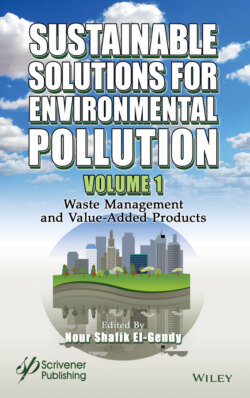Читать книгу Sustainable Solutions for Environmental Pollution - Группа авторов - Страница 17
1.3.1.1 Short-Chain Carboxylates
ОглавлениеVarious short-chain carboxylates, such as acetate, propionate, butyrate, etc., can be produced via microbial fermentation of organic feedstocks, including waste biomass. The acidogenic fermentation of complex organic substrates with mixed consortia can produce a mixture of various short-chain carboxylates (also called volatile fatty acids) in the fermentation broth (Paiano et al., 2019). These short-chain carboxylates can be either extracted or incorporated within other bioprocesses. However, a standalone acidogenic fermentation process is yet to be developed for industrial-scale synthesis of short-chain carboxylates (Paiano et al., 2019). Over the past few decades, significant research efforts have been dedicated towards developing strategies for long-term operation of acidogenic fermentation, optimization of process parameters (e.g., retention time, pH, temperature, substrate concentration, etc.), tuning the product spectrum (i.e., composition of carboxylates) (Arslan et al., 2016; Paiano et al., 2019).
Recently, EF has been investigated for various short-chain carboxylates production (see Table 1.1). These studies showed promising results in enhancing the yield and productivity of short-chain carboxylates with pure and mixed-culture. For example, Villano et al. (2017) studied cathodic EF of single and mixtures of substrates (glucose, ethanol, and acetate) with undefined mixed culture. Their results showed an applied potential of -700 mV vs. SHE could increase iso-butyrate production over the control (open-circuit reactor) by 20-fold (0.43 vs. 0.02 mol/mol glucose) for a mixture of glucose, ethanol, and acetate. Interestingly, iso-butyrate yields were quite comparable for both reactors when operated with glucose as a sole substrate and a combination of glucose plus ethanol or glucose plus ethanol. Thus, their results suggested that in the presence of applied potential and mixture of substrates could stimulate the growth of iso-butyrate producing microbial population. Although no exogenous redox mediator was provided in the fermenter, cyclic voltammetry (CV) of microbial culture showed a reduction peak at -700 mV vs. SHE (same as operating working electrode potential of EF system). Thus, the authors concluded that applied potential altered the redox status of the cells by shifting intracellular NADH/NAD+ ratio, which subsequently redirected their metabolic pathway towards iso-butyrate production. Recently, another study by Paiano et al. (2019) also reported a 4-fold higher n-butyrate yield with unmediated mixed-culture cathodic EF at an applied potential of -700 mV vs. SHE. The authors found that iso-butyrate yield could reach up to 0.6 mol/mol glucose when the system was operated with glucose along with its fermentation products. Furthermore, the authors performed mediated EF tests using Neutral Red and AQDS as exogenous mediators. Only the n-isomer of butyrate was produced in the presence of these mediators, suggesting mediators could introduce a high selectivity towards specific compounds.
Figure 1.3 A conceptual schematic showing combined anodic acidogenic EF coupled with cathodic EF of off-gases produced during anodic EF. The figure drawn with modification after Zhou et al. (2019).
Recently, a study by Zhou et al. (2019) combined anodic acidogenic EF of glucose coupled with cathodic EF of off-gases produced during anodic EF to improve the yield of mixed volatile fatty acids (see Figure 1.3). Their results suggested that the conversion of off-gases (mainly CO2+H2) to mixed volatile fatty acids on the cathode enriched with homoacetogens could contribute to ~14% of the overall VFAs recovery from the integrated process. to improve the product and carbon conversion. Thus, the development of such engineering strategies could further improve product yield from EF.
